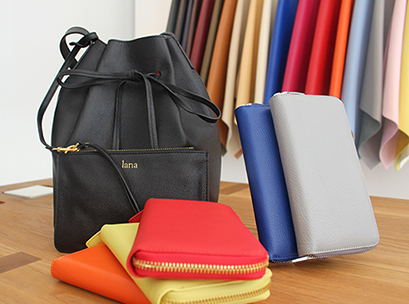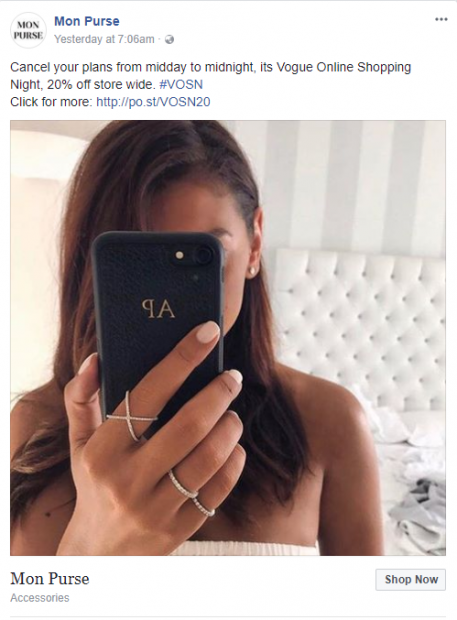 Mon Purse’s explosive growth has become somewhat of a textbook example of ecommerce disruption in the industry after founder Lana Hopkins started the personalised handbag offer in 2014. Since then the company has expanded overseas and into bricks-and-mortar, becoming a well known retail brand amongst digital natives.
Mon Purse’s explosive growth has become somewhat of a textbook example of ecommerce disruption in the industry after founder Lana Hopkins started the personalised handbag offer in 2014. Since then the company has expanded overseas and into bricks-and-mortar, becoming a well known retail brand amongst digital natives.
Behind that success has been a robust social media strategy. With more than 45,000 Facebook likes and 80,000 Instagram followers, the company has invested heavily in the eyeballs of tech-savvy millennials.
Inside Retail sat down with Mon Purse’s head of ecommerce, James Hopkins, to have a chat about how the brand has navigated the social space at a time when theories about how to maximise the value of digital marketing are seemingly endless.
IR: Give us a bit of background James – what role does Facebook and Instagram play in Mon Purse’s business?
JH: They’re both really important tools for us, they have been since we launched the business.
Obviously as our audience as grown and the business has grown and the offering has evolved with both platforms we’ve stayed really across both of them to leverage the most that we can in terms of functionality and features.
We weren’t actually using the Facebook platform to managing our campaigns originally, we we’re actually using a third party. I found that they’d not been able to keep up with what Facebook has been doing so over the last couple of months as a team we’ve had to go and re-learn how to walk, and re-think about how we plan and strategise a campaign so that we’re using what’s native on Facebook as opposed to a third party offering.
Its a lot of trial and error. Obviously you’re not looking at 60x ROI each and every day, there’s certain conditions and factors that need to come into play to really get those numbers.
IR:What type of campaigns have worked for Mon Purse?
JH: We ran a campaign a little while ago that actually generated a return on investment of 121x so its double that 60 number. That was a six week campaign that was laser pointed on abandonment behaviour.
We targeted people who’d started to design their own handbag, but they hadn’t finished that process. So we knew they had an understanding of the brand, we knew that they had gone and played with the tools, but they just didn’t actually either add the bag to cart or take it any further. From what we understood they were just having a play around.
We spent $283, and again we’re not talking massive amounts of scale here, and it had a seemingly unsustainable cost-per-click (CPC) of $6.74, but it was interesting because we had an overall cost cost-per-acquisition (CPA) of just $5.30 and its not everyday you see the CPA lower than the CPC, which made that one quiet unique. In the end it delivered that 121x ROI, and we saw nearly $37,000 in revenue from an investment of under $300.
 We also run what we call ‘evergreen’ campaigns, which is one that’s constantly going. In the last thirty days we’ve spent $1,300 on those and have reclaimed 135 customers that have abandoned their cards – so with $10 per purchase we’ve generated nearly $17,000 in revenue.
We also run what we call ‘evergreen’ campaigns, which is one that’s constantly going. In the last thirty days we’ve spent $1,300 on those and have reclaimed 135 customers that have abandoned their cards – so with $10 per purchase we’ve generated nearly $17,000 in revenue.
What’s interesting about that for me is that the creative, in this case an iPhone cover, isn’t dynamic to what the customer abandons, its just a great piece and that clearly resonates with customers, showing them that their entry level to the Mon Purse brand is quiet accessible.
From a marketing perspective its about trying to leverage these events that happen on the site, finding a sweet spot in the moment that you’re most likely to engage with the customer and get that conversation.
The other element we’ve also found successful on Facebook lead generation campaigns, that’s a tactic that’s worked pretty well for us in both delivering new leads that in fact make the purchase very quickly.
We did one that had a $17,000 spend and delivered around $80,000 in new revenue through 1,350 new leads and 35 of those made a purchase in the first seven days.
The remainder sat at around 60 per cent after 30 days, so definitely a revenue positive experience and a database growth experience and bringing those two together.
IR: Social media has been touted for its two-way communication capabilities with customers, what’s that look like for Mon Purse in terms of customer engagement both pre and post purchase?
JH: It evolves, and it’s really a time consuming aspect of the social media programme in terms of engaging one-on-one with your customers – which was what everyone was shouting about in the early days of social media.
There’s obviously tools now that can be used to auto respond and all of those things – we don’t do any of that.
We try and engage with our customers at an authentic and personal level. Given that we’re a business that’s about personalisation that’s important to us. On Instagram the functionality is getting better and better there in terms of having a thread where we can have a conversation, so we continue to use it very much as a Q&A function.
We get a lot of questions about what bag is that? What colour is that? Where are those shoes from? So you use those opportunities to build a relationship with your customers.
IR: What are the differences between Facebook and Instagram from your perspective?
JH: You just have to try and leverage the functionality. From a Facebook perspective now we can tag our products in the feed, so we can include products in our posts and have that link directly back to the site.
I’m truly excited for the day that those beta tests on Instagram come to Australia because I’m seeing some of these brands in the US getting shoppable links and I think personally that will be pretty valuable to us in time.
Its about evolving your strategy as the functionality evolves and trying and testing new things.
We’ve been loving using the Facebook pages app on our phones recently because If you jump into a piece of content you can actually just invite everyone who likes that piece of content to like your page, its a good little trick and is quite a cost effective way of building new likes.
IR: What does cross-over look like between the platforms?
JH: Where we’ve seen a lot of success in the last two months since it was released is around those new options such as re-targeting people who have been on Facebook, but have engaged with your Instagram profile. Those are the sorts of crossovers that we’ve found to be quiet useful and lucrative.
Then of course building those out to someone who has purchased and building it out further to create a look-a-like of those audiences has been something that’s been of benefit to us.
IR: There’s been a big conversation about organic versus paid social media spend and how that should be navigated by retailers, what are your thoughts there in terms of when Mon Purse will use one rather than the other, vice versa?
JH: We don’t really look at it that differently, I think you have to look at what objective you want to take from the creative and what your purpose for that post, whether its a newsfeed post or whatever the content is. If you see that content is getting some engagement and is sticky then you should be putting some spend behind it.
That’s the bottom line in reality, we haven’t found that we’ve managed to crack the code and get that piece of content that does get that massive massive organic virality or anything like that – we’re working on a few ideas there, but at the end of the day you’ve got to pay for your eyeballs.






